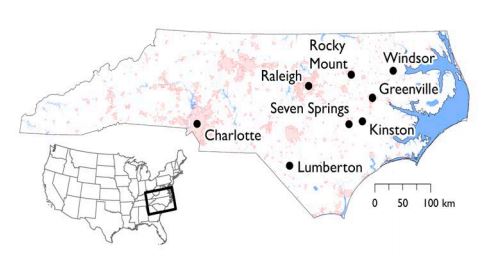The devastating impacts of Hurricane Florence to residents and businesses in eastern North Carolina remind us of just how vulnerable the state is to severe storms and flooding. Hurricane Florence produced torrential rains causing severe flooding that breached levees, closed major roads and inundated entire communities. Thousands of homes in the eastern part of the state were destroyed.

Unfortunately, many of those impacts were felt most acutely in the regions of the state that were still in the process of recovering from Hurricane Matthew, which struck in October 2016. Many of the homes that flooded from Florence had also flooded from Matthew and some of these same homes had even flooded before during Hurricanes Fran and Floyd in the late 1990s.
Sponsor Spotlight
To reduce the risks of future flooding, communities across the state have been acquiring and removing the most vulnerable homes from the floodplain. These acquisitions, known as buyouts, are funded primarily by the Federal Emergency Management Administration (FEMA). Since the 1990s, FEMA has funded the acquisition of over 50,000 homes, including some 5,000 homes in North Carolina.
By removing homes from harm’s way, buyouts can permanently reduce a community’s vulnerability to flooding.
Homes that are acquired with FEMA funds must be removed or demolished and the land protected in perpetuity as open space. By removing homes from harm’s way, buyouts can permanently reduce a community’s vulnerability to flooding. However, buyouts also can reduce the local tax base and stick local governments with the bill for maintaining the now-vacant properties. Since buyouts are strictly voluntary, not all eligible homeowners participate, thus limiting the use of the acquired lands. The most common use of buyout lands is vacant lots. Although some communities, such as Charlotte and Rocky Mount, have created parks, community gardens and greenways.
In response to Hurricane Matthew, over the last year we have been leading a team of researchers at UNC-Chapel Hill to study and identify ways to improve floodplain buyouts in North Carolina.
The goals of the study were to estimate the net financial impacts of buyouts on local governments in North Carolina and to explore the factors that might motivate people to participate in a buyout.
Sponsor Spotlight
The project examined the impact of buyouts in eight communities: Charlotte, Greenville, Kinston, Lumberton, Raleigh, Rocky Mount, Seven Springs and Windsor. These communities vary in size from Seven Springs (pop. 110) to Charlotte (pop. 842,051). As part of the study we met with local officials, created GIS maps of buyout areas, and collected financial data to estimate the loss of tax base and the costs associated with maintaining the buyout properties.

We also tried to estimate the savings, or avoided losses, that the buyouts will provide during future floods. What expenses will the community not incur because the acquired homes will no longer be there to flood?
Our research findings suggest the financial impact of a buyout varies by community and depends on a number of factors, including:
- The spatial pattern of the buyout. For example, many buyouts resemble a checkerboard, with vacant homes interspersed among occupied houses. With this pattern of acquisition, most communities simply plant grass on the vacant lots and mow regularly. This can be costly, with few environmental benefits.
- Future use of the property. Some communities have created a community amenity, such as a park, out of the acquired lands. Others simply lease the isolated, vacant lots to adjacent landowners. The spatial pattern of the buyout largely determines what the community can do with the land afterwards.
- Where people go. If buyout participants leave the community, then the community suffers a loss of tax base. In many cases, participants are able to find replacement housing within the community. Everyone benefits if communities can quickly help buyout participants find local and non-flood prone housing.
- What costs get reimbursed. Federal and state grants often cover the bulk of local expenses during buyouts if they are in response to
- State or federally-declared disasters. In cases where flooding is localized, local governments can be made to foot much more of the bill.
Our final report contains a number of recommendations, including the need to develop incentives at the state level that allow for efficient and complete buyouts rather than a scattershot approach. Importantly, policies and funding should support participants in the buyout to relocate to affordable housing as close as possible to their existing community (and in areas that are not prone to flooding).
As state lawmakers and state agency officials begin the long process of helping communities recover from Hurricane Florence, improving the flood plain buyout process offers an opportunity to make the state more resilient for future storms and protect residents in vulnerable areas.
Learn More
To stimulate discussion and debate, Coastal Review Online welcomes differing viewpoints on topical coastal issues. See our guidelines for submitting guest columns. The opinions expressed by the authors are not necessarily those of Coastal Review Online or the North Carolina Coastal Federation.







